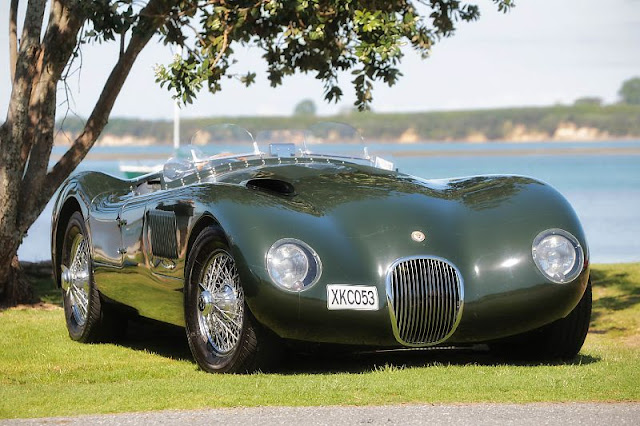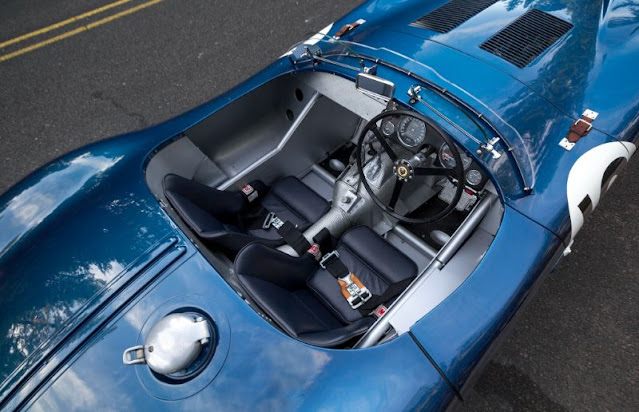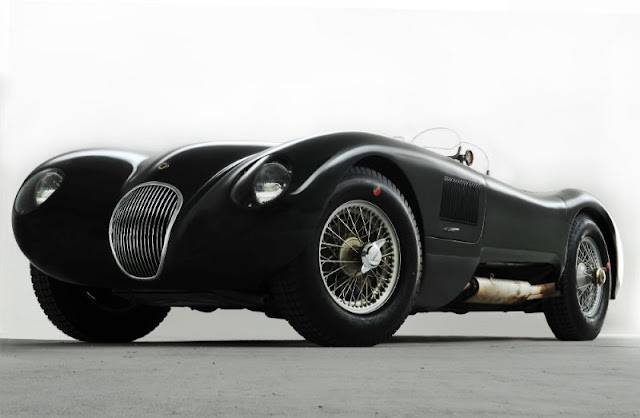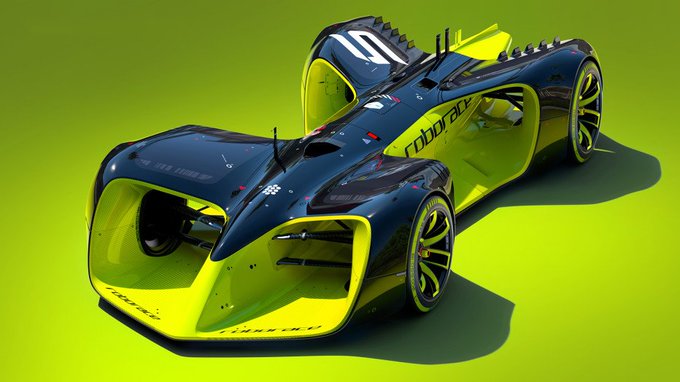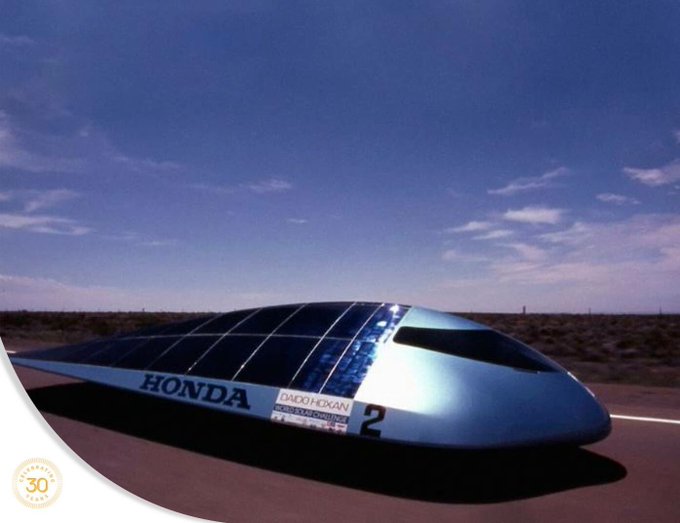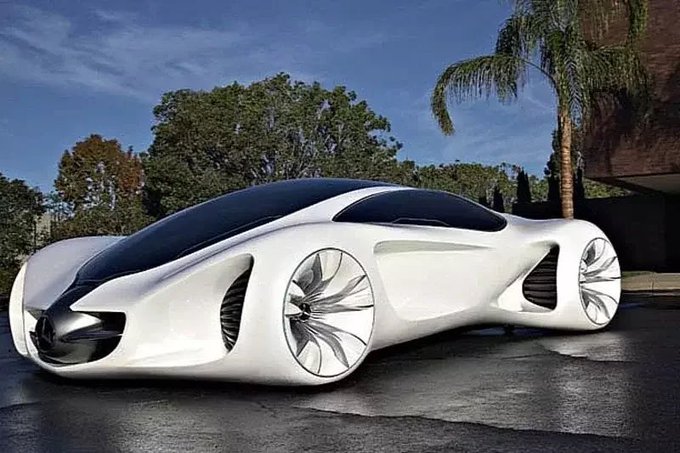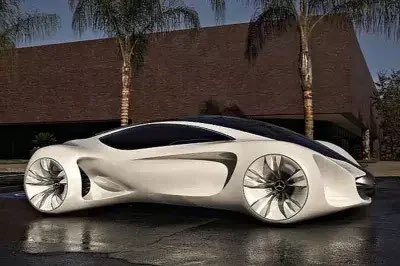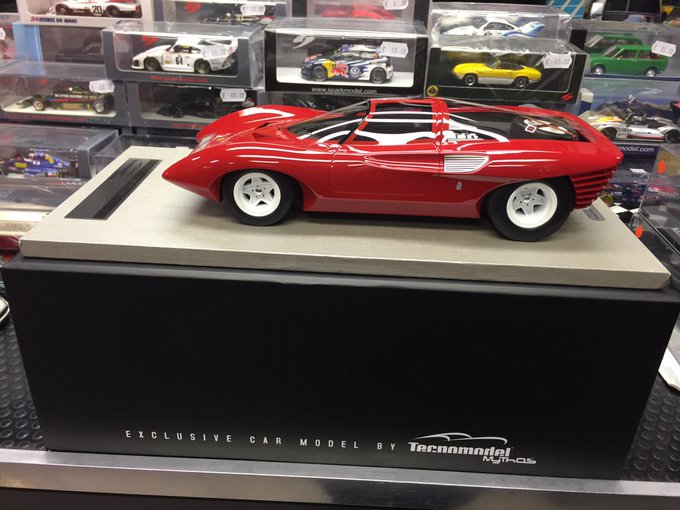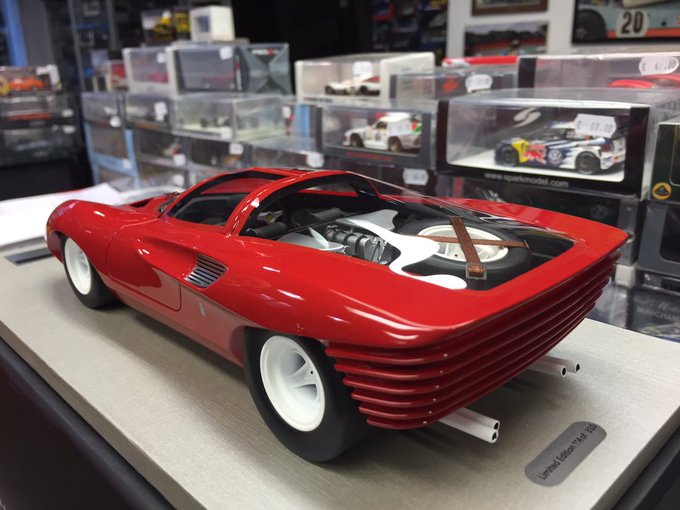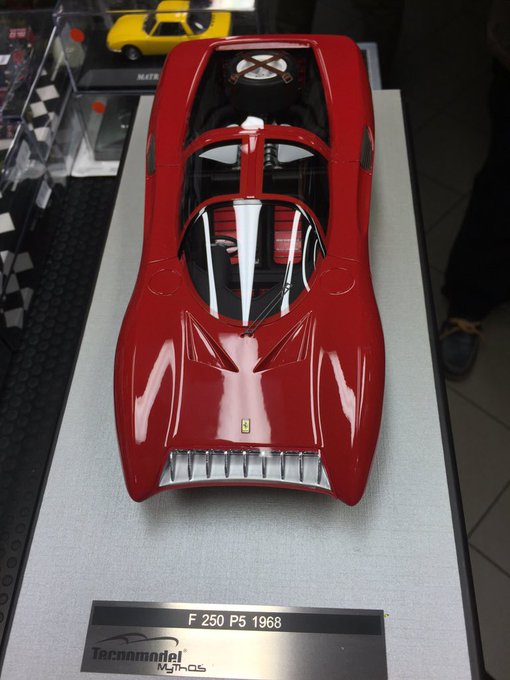Most cars are mass produced, but others are so outrageously rare they’re tucked away in the depths of museums or purchased by the mega-wealthy for millions! From ultra-classic to wildly weird, buckle up and hold tight as we drive through the rarest cars of all time.
Jaguar XK120-C
There’s just something cool about things named after big cats, such as the Jaguar XK120 C-Type. Winning its debut race in the Le Mans 24-hour in 1951, and then again in 1953, this swift supercar dramatically zoomed onto the world stage, beating out other industry giants such as Talbot, Aston Martin and Ferrari.

Designed by engineers Bob Knight and Malcolm Sayer, the C-type had a light tubular frame and aerodynamic body made of aluminum, giving it an edge on the track by being lighter than previous versions. It was designed after its mother-model, the XK120, which at the time was already the fastest race car in the world, reaching up to 120 mph. While that's already fast, the C-type could hit a blistering 140mph. And if you’re wondering what’s up with that funky asymmetrical design, Sayers wanted to fit the car’s upgraded 220BHP engine beneath the hood but also keep it as low to the ground and aerodynamic as possible. So, the side with the engine is a little higher while the other side remains lower down, leading to that lopsided bulge. But it the XK120 C-Type whisked off as fast as it came, with production ending in 1952 after just two short years on the scene. Only 53 were ever built, making it the rarest model of all the racing Jaguars. And that means if you want to get your hands on one, it’s gonna cost you a pretty penny. More than half a century later, one of the models was restored and
auctioned off to collectors, where it revved up the hefty price of $13.2 million!
The Bugatti Royale
Imagine a car so huge its engine was used to power railcars. A car so expensive that only a handful were ever made, to be sold exclusively to royalty. Thinking diamond-plated wheels? Sunroof top? Slick, slim and fast? Maybe, think again.
An absolute beast of a vehicle, weighing around the same as a truck, the Bugatti Type 41 Royale Kellner Coupe was in production between 1927-1933. A whopping 7,000lbs of glitz and glamor, the
Royale is one of the largest and snazziest cars ever made. And to say it’s rare is an understatement, only six ever made it to production and the original prototype was destroyed in an accident. Forget rare, this thing is bordering on mythical!

It's said to have been built by Ettore Bugatti after he took offence to an English woman’s comments that his cars were too similar his competitor’s, Rolls-Royce. So, he decided to make this new model astronomically luxurious and pricy. At a colossal $30,000, the Royale was three times the price of its competitors and 10 times that of any other Bugatti vehicle, a figure equating to over half a million dollars today. A paradoxically prestigious artefact of the Great Depression, it’s unsurprising that only three were sold, and none ended up going to royalty.Luckily, all six models still exist today. Some are on display in museums while others have been snapped up by the ultra-wealthy! It’s unlikely that any of us will ever get behind the wheel of one though unless it’s in GTA of course.
Lamborghini Veneno
When you think Lamborghini, you think prestigious. The Italian car manufacturer has become known for its speedy cars, celebrity clientele, and dominance on the racetrack since it crashed onto the motoring scene in 1963. But it’s the Veneno, launched for the company’s 50th anniversary, that really made a statement.
The car was unveiled at the Geneva Motor Show in 2013 and created to encapsulate the manufacturer’s half-a-century reputation of technological and stylistic evolution. Capable of holding its own as a serious race car, the Veneno is powered by a huge 6.5-Liter engine and can reach mind-blowing speeds of 220-mph, blasting from 0 to 62 in a mere 2.8 seconds!
Lamborghini Veneno roadster on the track! Exhaust Sound, Acceleration! by CARSNCO But it’s also approved for road use, theoretically making it available for you and me! Don’t get too excited though, as only 13 were ever made, and all of them sold for 3 million euros before they were even unveiled!
The RoboRace
The world’s first purpose-built autonomous racing car, this AI powered tech wonder was designed by German concept designer Daniel Simon, who’s also responsible for the vehicle designs in movies like Tron: Legacy and Oblivion.
Knowing of his impressive resume, the founders of Roborace, the first racing competition between autonomous, electric-powered vehicles, commissioned Simon for the task of designing the vehicle they wanted on their track. The idea was, every competitor would have the same autonomous vehicle, but it would be the way they programmed their car that would determine its performance on the track.So, Simon got to work. Dubbed the AI supercar, the base frame is shaped like a teardrop, giving it aerodynamic efficiency. Notice that asymmetric design too? While no official reason has been given publicly, it's likely a combination of balancing the weight of the internal power and motor technology inside the vehicle, while keeping it as aerodynamic as possible. And with four electric motors all utilizing a 540-volt battery, it’s sustainable too! No fossil fuels being exhausted here.
But what about the AI? How does that work? Well, to drive itself the car uses a whole host of top-of-the-line technologies including radar, sensors, AI cameras, and even satellites. And powering all this is a specialized piece of Nvidia software capable of up to 24 trillion AI operations a second. However, when it made its debut on the streets of Paris in May 2017, crowds were less than blown away. Sure, it was autonomous, but rolling at a snail’s pace up a preset piece of track isn’t the most impressive demonstration. Still, this was 2017 and AI had a long way to go.
Roborace at Paris 2017 (2pm demo - 2nd run) by robotikacz So, what of the Roboracer now? Sadly, Roborace went defunct in 2022. So, the handful of vehicles that were produced won’t be seeing the light of day anytime soon. But the Roboracer still has a place in history as one of the first uses of AI in both sport and transport!
The Leyat Helica
Leyat Helica is a car with a propeller, but this isn’t something out of Whacky Racers. It's the brainchild of French inventor, aviator, and car manufacturer Marcel Leyat. The genius inventor was known for having designed, built, and flown his own plane back in 1909, just 6 years after the airplane was first invented!
Believing the cars of the early 1900s were too heavy and inefficient, Leyat took his knowledge of airplane development and brought it to the automobile world. By sticking a great big propellor on the front. If you think that sounds like a dumb idea, you’d be right.
Nobody can argue against Leyat’s gifts for engineering and design, but not every idea a genius has is a good one. Rather than make the vehicle more aerodynamic, as Leyat had hoped, the propellor only served as a danger. For starters, its bulky design obscured the driver’s view and blew wind into their face. Even worse, although models on display at museums today have covered the huge propellor with a wire mesh shield, that wasn’t part of the original design. Put it this way, you’d definitely never go jaywalking again with these things haphazardly barreling down the road at you!
Fortunately for Leyat only 30 Helicas were ever built, so he didn’t throw his life savings at the project. Unfortunately for Leyat only 23 of those were sold. Unsurprisingly then, this plane without wings never found its place on the road. But even so, it’s still a testament to the boom of technology and new ideas that emerged in the early twentieth century.
Mercedes Benz Alloy Gullwing
So, if there's a car that looks like a plane, how about one that looks like a bird? Created by Mercedes chief engineer Dr. Fritz Nallinger, the Alloy Gullwing glided into public attention at the 1954 New York Auto Show. Named Gullwing due to its upward-opening doors that look a little like a seagull flying, the boldly designed car was at the cutting edge of technology and design at the time.

There were actually several different types of Gullwing, but while the others were manufactured in the thousands and made of steel, the Alloy Gullwing is special. Only 29 were ever made, and they were built primarily out of light aluminum, making them over 170-lbs lighter than the other models. And with all windows besides the windshield cut from the lighter glass alternative plexiglass, the Alloy Gullwing doesn’t just look cool, it was built to race. A fact confirmed by the state of the art 3.0-liter engine, ensuring it can reach 60-mph in under nine seconds and hit a top speed of around 150-mph, very impressive for the time it was made.
However, getting behind the wheel of one of these classic cars is very unlikely; only 24 still exist! And they go for a lot. One was
sold in 2022 for a whopping $6.8 million by auctioneer RM Sotheby’s, who described it as the sports car of the century.
Honda Dream II
You’ve probably seen solar panels before. Some people line their roofs with them to provide their homes with environmentally friendly energy. But how about a solar powered car? The weird looking automobile below is the Honda Dream II, and though it might not be the fastest car ever, it makes up for it with sheer ingenuity.
Indeed, back in the 1990s it won the 1,864-mile
World Solar Challenge, where a host of solar powered vehicles race against each other across Australia. And it did so with a relatively modest average speed of 56mph.Powered entirely by solar energy, the Honda Dream II stole the stage not just for its superiority on the track, but that crazy next-generation turtle-like design. Its shell is covered with 25 square feet of solar panels that absorb sunlight and convert it into electricity to power the car.
Honda Dream II Solar Car - Top Gear 1994 by Dangermuffin
But what if the sun goes in? No problem! It’s also equipped with batteries that absorb any electricity left over, so even at night it’ll continue to run! These aren’t your standard AAs though, they make up a third of the vehicle’s overall weight! To compensate, the Honda Dream II was built from lightweight carbon fiber reinforced plastic. This way, it could withstand the long journey of the World Solar Challenge while retaining a good speed.But how rare is this supremely odd vehicle? Well, about as rare as they come. As far as I’m aware, only one was ever made, built specifically for the World Solar Challenge, which is why you’ve never seen it out on the highway. Even so, that’s still more common than the
Mercedes Biome, a truly wacky idea for an eco-friendly vehicle that, unlike the Dream, never made it past the design stage. According to Mercedes, it would be grown from genetically modified seeds and a super strong biodegradable material called “BioFiber”. If that isn’t insane enough, it’d also run off “Bio Nectar” instead of gas, the only by-product of which would be oxygen. Just how exactly any of this would be possible, or indeed if “bio nectar” was even a real thing, they were suspiciously tight-lipped about.
Ferrari 250 P5 Berlinetta Speciale
Whether it’s movie directors or musicians teaming up, everyone loves collaborations. But car manufacturers? That’s less common, but it was the case with the Ferrari 250 P5 Berlinetta Speciale. Built as a joint effort by Ferrari and Pininfarina and designed by mechanical engineer Leonardo Fioravanti, the Berlinetta Speciale first appeared at the 1968 Geneva Show.
With a slick visage and a super cool rear window that exposes the tail-mounted three liter V12 engine, you might imagine it was applauded for its unique design. But many people did quite the opposite, seeing it as too radical at the time. However, despite the P5 never coming out of the concept phase, it did influence many future Ferraris, mainly with that clear glass over the engine. Not that it was just a fashion statement. Weighing just under 1,500-lbs, about as much as a cow, the P5 was super-light and could reach speeds of up to 186-mph! A shame it was never given the chance to race, then.
Mercedes-Benz 300 SLR Uhlenhaut
Some cars are so rare, people will pay more than a hundred times the price of a private island to get hold of one. Take the James Bond-esque Mercedes-Benz SLR Uhlenhaut. In May 2022, one of the only two models manufactured went for an eye-bulging $147 million.

One of 1955’s Mercedes-Benz 300 SLR Uhlenhaut Coupés, catchily named after the car’s creator and chief engineer Rudolf Uhlenhaut, was auctioned off for the huge fortune. The sale was record-breaking, making it not just one of the world’s rarest cars, but also the world’s most expensive! Its twin, the only other model in the world, is on display at the Mercedes-Benz Museum in Stuttgart and won’t be going on sale anytime soon. Not that it’s just for looking at. If the lucky buyer decides to take their model for a spin, the two-seater sports car can reach dazzling speeds of 180mph. The looks certainly don’t harm it though. Fitted with a slick red interior and doors reminiscent of the Mercedes Gullwing, it oozes simple but sophisticated individuality.
RM Sotheby's—The Most Valuable Car in the World by RM Sotheby's
And while you and I will never drive it, the anonymous buyer did agree
to allow the car to be displayed for special occasions, so you could still be lucky enough to catch a glimpse in person!
Batmobile Replica
YouTuber Supercar Blondie is known for searching out and reporting on the coolest cars in the world. And in 2022, they discovered perhaps the coolest car in human history: a working replica of the Batmobile from Batman vs Superman: Dawn of Justice. Made from tough carbon fiber and fiberglass parts, the incredible replica is charged by a Ford F350 Raptor engine and can spit fire out of its exhaust!
Unlike many of the cars we’ve covered so far, this beast has no pretense of being lightweight. Its wheels alone weigh over 2,200lbs and it can only just fit on a flatbed truck. As menacing as it is though, budding criminals need not worry too much. It’s only legally drivable in Dubai, and with the city’s famously low crime rate, it’s unlikely old Bats will be needed there.
Wienermobile
The Wienermobile is a huge 27-foot-long hotdog on wheels, created by American meat and cold cut producer, Oscar Mayer. Initially developed during the Great Depression as an elaborate marketing ploy, it was first seen in 1936 and could be found cruising the streets of Chicago.

Back then it was only 13 feet long, but this original model, featuring a special purpose-built chassis, would soon be zipping across the USA, delighting and confusing adults and children alike. Though there have been several incarnations of the Weinermobile over the years, the current 27-foot monstrosity is a custom-made fiberglass vehicle with a GMC chassis, powered by a 6 liter V-8 engine. And it has only six models in use across the States today, with twelve drivers, called hotdoggers! You can apply to become a hotdogger, but it’s not easy. The main purpose of the vehicle is marketing, so it’s not as simple as owning a driving license! You also need to have a bachelor's degree, preferably in public relations, journalism, communications, or marketing. And even if you do get the job, you’ll only be hired for a year, making the Wienermobile a frankly exclusive vehicle that only a few will ever get to pilot.
Captain Nemo’s Nautilus Car
From the glamorous homes of sports stars to music videos where artists flash their copious cash, opulence is everywhere in pop culture. But is there anything more opulent than owning one of only two cars built for a big budget Hollywood action movie?
Captain Nemo’s six-wheeled Nautilus Car, as seen in the 2003 movie League of Extraordinary Gentlemen, was sold at a UK auction in 2015 for around $40,000, which actually doesn’t sound like that much! Comparatively, at least, as there’s only two of them in the whole world! And despite being a movie prop, the car is fully functional.

© 20th Century Fox
Beginning its life as a Land Rover fire tender, it was adapted with a steel frame decorated by an ivory-colored fiberglass chassis. Gold embellishments inspired by the Hindu God Ganesha top it all off, bringing both the interior and exterior to life. But, despite its functionality, it’s unlikely you’ll ever see this car on the road. The huge, 22-foot long and 9-foot-wide display of artistic ambition might look like road royalty, but it’s too wide to be legal on British roads. Maybe that played a part in its low selling price.
Shelby Cobra 427 Super Snake
Most people are absolutely terrified of snakes, but you wouldn’t expect that fear to extend to cars named after snakes. However, in 1966, the $5.5 million Shelby Cobra 427 Super Snake slithered onto the international sports car scene, and quickly proved itself worthy of fear.
Dubbed "the Cobra to end all Cobras" because of its incredible performance, this supercar features a huge 7 liter engine and can hit absolutely insane speeds of over 200-mph! For 1966, that’s unheard of. And it’s even more special because only two were ever made! One for American automotive designer Carroll Shelby himself, and one for a friend of his.
Said friend was supposedly so afraid of the Cobra’s power that he was worried he couldn’t control it and returned it to Shelby after just one drive. Turns out, that may have been the right move because the eventual owner of the car ended up accidentally driving it into the Pacific Ocean!

So, now there’s only a single one of these speed demons left. And yes, that is the right word. Fitted with two superchargers under the hood that compress the engine’s intake gas, forcing more air inside and producing greater power, the 2,550lb car can hit 60-mph in just three seconds! It's understandable why it’s been described as the most dangerous sports car to have ever existed! But speed alone isn’t the issue. The body is also made of aluminum, which is lighter than steel, making for a faster and more maneuverable vehicle. The problem is, when exposed to high temperatures like the heat from a powerful car engine like the Super Snake’s, aluminum expands. And upon cooling again, it can leave stress tears, which weaken the vehicle and make accidents much more likely to happen. If you were amazed at the rarest cars of all time, you might want to read about the most
luxurious cars in the world. Thanks for reading!





